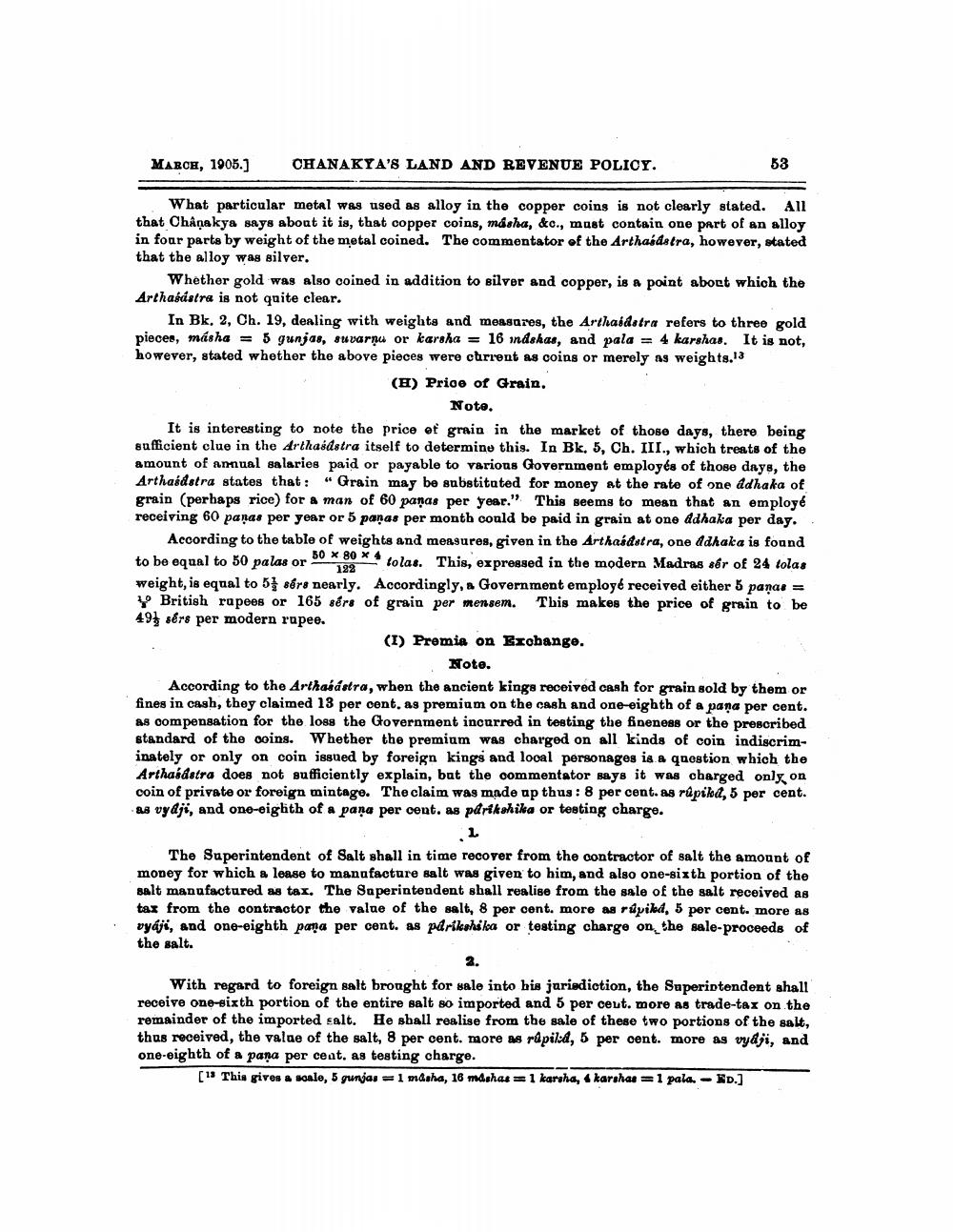________________
MARCH, 1905.]
CHANAKYA'S LAND AND REVENUE POLICY.
53
What particular metal was used as alloy in the copper coing is not clearly stated. All that Chanakya says about it is, that copper coins, másha, &c., must contain one part of an alloy in four parts by weight of the metal coined. The commentator of the Arthasdetra, however, stated that the alloy was silver.
Whether gold was also coined in addition to silver and copper, is a point about which the Arthasastra is not quite clear.
In Bk, 2, Ch. 19, dealing with weights and measares, the Arthaídstra refers to three gold pieces, másha = 5 gunjas, suvarņu or karsha = 16 indehas, and pala = 4 karshas. It is not, however, stated whether the above pieces were current as coins or merely as weights.13
(8) Price of Grain,
Note. It is interesting to note the price et grain in the market of those days, there being sufficient clue in the Arthasdstra itself to determine this. In Bk. 5, Ch. III., which treats of the amount of annual salaries paid or payable to various Government employés of those days, the Arthasdstra states that: “ Grain may be substituted for money at the rate of one ddhaka of grain (perhaps rice) for a man of 60 panas per year." This seems to mean that an employé receiving 60 panas per year or 5 paņas per month could be paid in grain at one ddhaka per day.
According to the table of weights and measures, given in the Arthaádstra, one Adhaka is found to be equal to 50 palas or 50 * * tolas. This, expressed in the modern Madras sér of 24 tolas weight, is equal to 5) sárs nearly. Accordingly, a Government employé received either 5 panas = y British rupees or 165 sérs of grain per mensem. This makes the price of grain to be 49 s&rs per modern rupee.
(I) Premia on Exchange.
Note. According to the Arthasástra, when the ancient kings received cash for grain sold by them or fines in cash, they claimed 13 per cent, as premium on the cash and one-eighth of a pana per cent. as compensation for the loss the Government incurred in testing the fineness or the prescribed standard of the coins. Whether the premium was charged on all kinds of coin indiscriminately or only on coin issued by foreign kings and local personages is a question which the Arthaídstra does not sufficiently explain, but the commentator says it was charged only on coin of private or foreign mintage. The claim was made ap thus: 8 per cent. As rúpild, 5 per cent. 8.8 vydji, and one-eiglith of a pana per cent. as parikshika or testing charge.
The Superintendent of Salt shall in time recover from the contractor of salt the amount of money for which a lease to manufacture salt was given to him, and also one-sixth portion of the salt manufactured as tax, The Saperintendent shall realise from the sale of the salt received as tax from the contractor the value of the salt, 8 per cent. more as rúpiled, 5 per cent. more as vyáji, and one-eighth pana per cent. as pdrikshika or testing charge on the sale-proceeds of the salt.
With regard to foreign salt bronght for sale into his jurisdiction, the Superintendent shall receive one-sixth portion of the entire salt so imported and 5 per ceut. more as trade-tax on the remainder of the imported salt. He shall realise from the sale of these two portions of the salt, thus received, the value of the salt, 8 per cent. more as rápild, 5 per cent. more as vydji, and one-eighth of a pana per ceat, as testing charge.
[15 This gives a sale, 5 gunjas = 1 mdaha, 16 mdahas = 1 karaha, 4 karshas = 1 pala. -ED.]




